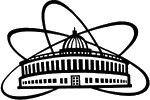
for Nuclear Research
research
for experimental
investigations
Programme
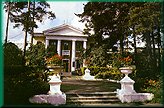
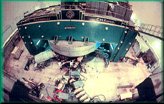
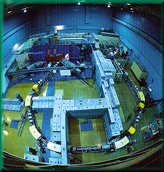
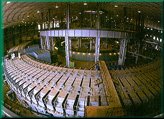
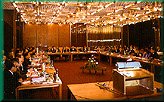
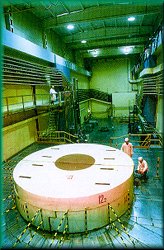
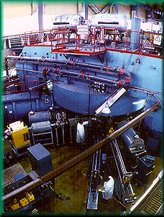
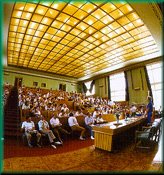
![]()
The Joint Institute for Nuclear Research (JINR) is an
international intergovernmental organization located in Dubna,
not far from Moscow, was established within the framework of the
Convention signed by the Plenipotentiaries of the governments
of the Member States in March 1956 in Moscow.
The Joint Institute was created in order to unify the
intellectual and material potential of Member States to study
the fundamental properties of matter.
The JINR Charter was adopted in 1956 , the new edition
of the Charter was readopted in 1992.
In accordance with the Charter, the Institute's activity
is realized on the basis of its openness, mutually beneficial
and equal cooperation for all interested parties to
participate in research.
The aim of the Institute is
to carry out theoretical and experimental investigations on
adopted scientific topics;
to organize the exchange of scientists in carrying out
research, of ideas and information by publishing scientific
papers, by organizing conferences, symposia etc;
to promote the development of intellectual and professional
capabilities of scientific personnel;
to maintain contacts with other national and international
scientific organizations and institutions to ensure the stable
and mutually beneficial cooperation;
to use the results of investigations of applied character to
provide supplementary financial sources for fundamental
research by implementing them into industrial, medical and
technological developments.
The results of investigations carried out at the
Institute can be used solely for peaceful purposes for the
benefit of mankind.
JINR is now a large multi-branch international
scientific centre with activities incorporating fundamental
research of the structure of matter, development and
application of high technologies, and university education in
the relevant fields.
The participation at the Institute can be realized in
different forms: on the basis of membership, bilateral and
multilateral agreements to perform separate scientific
programs. JINR Member States contribute financially to the
Institute's activity and have equal rights in its management.
JINR has at present 18 Member States:
Armenia Moldova
Azerbaijan Mongolia
Belarus Poland
Bulgaria Romania
Cuba Russian Federation
Czech Republic Slovak Republic
Georgia Ukraine
Kazakhstan Uzbekistan
D.P.Republic of Korea Vietnam
JINR has special agreements concluded with:
Germany in the field of theoretical physics, heavy ion
physics and condensed matter physics, high energy physics;
Hungary in the field of condensed matter physics.
Italy in the field of nuclear physics.
Scientific Partners of JINR
JINR has bilateral agreements with international organizations:
UNESCO United Nations Educational, Scientific and Cultural
Organization,
CERN European Organisation for Nuclear Research,
CLAF Latin-American Centre for Physics,
ICTP International Centre for Theoretical Physics.
JINR has bilateral agreements, protocols and other documents
concluded with 712 institutions in 57 countries, including:
IHEP (Protvino), Russian Research Centre "Kurchatov Institute",
ITEP, INP (Moscow), INP (St.Petersburg), BINP (Novosibirsk) and
other research centres in Russia;
BNL, LLNL, FNAL and other research centres in USA;
IN2P3 (France) in the field of nuclear and particle physics;
C.E.A. (France) in the field of radionuclide metrology;
Governing Bodies
The Committee of Plenipotentiary Representatives (CPR)
of the governments of the Member States is the supreme body
governing the Institute.
The Scientific Council and Finance Committee realize
their activities annually under control of the Committee of
Plenipotentiaries pursuant to the adopted Regulations.
In line with the new principles of the JINR Charter, the
membership of the Scientific Council was renewed in March 1999.
It consists now of:
- 18 appointed members from the Member States;
- 25 members elected by CPR: eminent and well-known scientists
Member States, CERN, CLAF, Germany, France, Italy, USA;
- director of JINR.
The Scientific Council:
a) evaluates the results of the scientific activities of the
Institute,
b) draws conclusions on the plans of scientific research of
the Institute, submitted by its Director and on the reports on
execution of such plans,
c) makes an expert examination of the proposals of the
Director on the development of new scientific programs and
projects,
d) works out recommendations o n the improvement of the
scientific activities of the Institute,
e) defines its own rules and procedures and submits them for
approval to the Committee of Plenipotentiaries,
f) sends its decisions and recommendations on the considered
issues to the Chairman of the Committee of Plenipotentiaries,
g) the Scientific Council holds its sessions at least two
times a year.
Programme Advisory Committees
The Programme Advisory Committees (PACs) are advisory bodies of
the JINR Directorate and to the JINR Scientific Council in
specific fields of research.
The PACs:
- consider proposals for experimental projects of JINR, at JINR
facilities as well as at facilities of other research
laboratories;
- review the progress of on-going projects;
- review projects for the development and upgrading of the JINR
facilities.
The JINR Scientific Council established PACs for:
· Particle Physics;
· Nuclear Physics;
· Condensed Matter Physics.
The structure of JINR is determined by scientific
specialization. JINR has 7 Laboratories and 2 Divisions:
BLTP - Bogoliubov Laboratory of Theoretical Physics,
LHE - Laboratory of High Energies,
LPP - Laboratory of Particle Physics,
DLNP - Dzhelepov Laboratory of Nuclear Problems,
FLNR - Flerov Laboratory of Nuclear Reactions,
FLNP - Frank Laboratory of Neutron Physics,
LIT - Laboratory of Information Technologies,
DRRR - Division of Radiation and Radiobiological Research,
UC - University Centre.
Besides, a number of associate Experimental Physics
workshops are also parts of the Institute.
The total number of JINR Personnel is about 4000.
Approximately 1100 scientists work at the Institute, among
them 10 Academicians and 8 Corresponding Members.
The budget of JINR adopted for 1999 by the Committee of
Plenipotentiaries is $37,5 million.
The permanent administrative body is the JINR
Directorate responsible for all research, financial,
administrative and social activities on the basis of the CPR's
decisions and recommendations, existing agreements and adopted
responsibilities.
Members of the JINR DIRECTORATE:
V.G. Kadyshevsky - Director;
A.N. Sissakian - Vice-Director;
Ts. Vylov - Vice-Director;
V.M. Zhabitsky - Chief Scientific Secretary;
I.N. Meshkov - Chief-Engineer;
A.T. Filippov - Director of BLTP;
A.I. Malakhov - Director of LHE;
V.D. Kekelidze - Director of LPP;
N.A. Russakovich - Director of DLNP;
M.G. Itkis - Director of FLNR;
A.V. Belushkin - Director of FLNP;
I.V. Puzynin - Director of LIT.
The main fields of the Institute's research are:
- theoretical physics,
- elementary particle physics,
- relativistic nuclear physics,
- heavy ion physics;
- low and intermediate energy physics;
- nuclear physics with neutrons;
- condensed matter physics;
- radiation biology and radiobiological research;
- networking, computing and computational physics;
- educational programme.
The principal facilities of the Institute for
experimental investigations are:
- nuclotron;
- U-200, U-400 and U-400M heavy ions cyclotrons;
- IBR-2 and IBR-30 pulse neutron sources;
- synchrophasotron;
- phasotron;
- computer centre.
IBR-2 is a reactor with the average power of 2 MW. The
pulse power is 1500 MW, pulse duration is 215 microseconds,
the frequency of pulse repetition is 5 per second, pulse
density of the neutron flux is 1016n/cm2/s.
IBR-30 is a pulsed neutron booster with the linear
resonance electron accelerator LUE-40 as an injector. The
average power of 10 kW, pulse duration is 4.2 microseconds, the
frequency is 100 per second, the average intensity is 3.6
1014n/s.
U-200 is an isochronous cyclotron to accelerate heavy
ions. It is designed to accelerate nuclei with (A/Z)=2.8-5 up
to 145Z2/A MeV with the beam intensity 108 - 109 ion/s.
U-400 is a heavy ion isochronous cyclotron. The range of
accelerated nuclei is (A/Z)=4-20, energy is 650 Z2/A MeV, beam
intensity is 1012 - 1014 ion/s.
U-400í is an isochronous cyclotron to accelerate heavy
ions. It is designed to operate in the cyclotron U-400+U-400M
complex and allows to accelerate ions from hydrogen up to
uranium in the range of energy 120 - 20 MeV per nucleon
correspondingly with the average beam intensity of 4 1013 -
1011 ion/s.
Synchrophasotron is an accelerator of 10 GeV protons as
well as of nuclei heavier than hydrogen such as deuterium,
lithium, carbon, fluorine and magnesium accelerated in the
broad energy spectrum from 100 MeV to 4 GeV per nucleon.
Average densities of beams have 104 ion/cm2/s to 1011
ion/cm2/s depending on the atomic number of accelerated
nuclei and experimental requirements. Polarized proton and
deutron beams are foreseen.
Nuclotron is a new super conducting accelerator. It will
permit to perform a wide program of research in relativistic
nuclear physics. The injection complex is being developed
consisting of a buster, linac and ion sources. This complex
will allow one to accelerate nuclei from hydrogen to uranium
with the intensity from 1013 to 108 particles per pulse and
the energy of 6-7 GeV per nucleon. Polarized deutron beams are
foreseen.
Phasotron is an accelerator of 680 MeV protons. 10 beam
channels are available at this machine which are used to carry
out experiments with pions, muons, neutrons and protons. 5
beam channels are designed to carry out medical
investigations. The intensity of the extracted proton beam is
2 mkA.
NEW BASIC FACILITIES
New basic facilities to carry out investigations able to
compete in future with other first class accelerator centers
are under consideration.
IREN project
IREN is the project of the Intense Resonance Neutron
Source aimed to the creation of the high flux pulsed neutron
source to carry out investigations with resonance neutrons.
The facility will comprise a modern 150 MeV electron linac and
a sub critical uranium booster having the neutron
multiplication coefficient of 14.
Networking, Information and Computing Infrastructure
In view of its wide scope of research, as well as the
world-wide collaboration, JINR is intensively developing its
networking, information and computing centre. JINR's High-
Performance Computer Centre and powerful net of servers,
workstations and PC - farms allow carrying out numerical
simulations of complicated multifactor problems of nuclear and
particle physics, creating modern computational tools for data
processing and data analysis. All computer units in JINR are
integrated into the local internal net and the world computer
nets.
INTERNATIONAL COOPERATION
BROAD INTERNATIONAL COOPERATION is one of the most
important principles of the JINR activity. Almost all
investigations are carried out in a close collaboration with
JINR Member States' scientific centers as well as
international and national institutions and laboratories in
the world.
JINR scientists are carrying out experiments at the IHEP
70 GeV proton synchrotron (Serpukhov, Russia) with the use of
such set-ups as HYPERON, Excharm, Neutrino Detector, and others.
A fruitful scientific cooperation is under way with
CERN, especially in the last few years, as well as with many
physics laboratories in USA, France, Germany, Italy,
Switzerland and other countries. Dubna specialists participate
in the experiments performed at the CERN and USA accelerators:
LEP, SPS, and Tevatron. New detectors for LHC (CERN) are being
designing.
JINR's ADVANCED TRAINING AND EDUCATION PROGRAMME
JINR gradually changes now from a purely scientific
research institution to an international centre, where
fundamental science, engineering and applied researches are
closely connected with training.
Structurally, it takes the form of a new satellite
"students" laboratory. Its prototype is the currently
operating University Centre (UC). This new training function of
JINR is supposed to be oriented to international demand. The
teaching is in Russian and in English, and the curricula will be
properly adapted to most common education systems. The
Institute's Laboratories will be a good basis for the students'
initial research. It is expedient to have student exchange for
practical work abroad, especially for CIS students.
International University "DUBNA".
On the initiative of the JINR Directorate and with active
support of the Russian Academy of Natural Sciences, Moscow Region
and Dubna administrations, an international university "Nature,
Society, Man" was established in Dubna, the first students
entering it in 1994.
The JINR University Centre
The University Centre of JINR offers training programmes in the
following disciplines:
elementary particle physics,
physics of high energy particle interaction,
physics of the atomic nucleus,
nuclear methods in condensed matter physics and
high-temperature superconductivity,
radiobiology,
accelerator physics.
The graduates of the University Centre presented their
diploma papers in January-February. There were about 100
students in the spring and autumn semester.
Students have access to the laboratories of JINR and can
work with the scientists and staff of the Institute, as well as
to study under professors who are eminent in their field.
The full-time educational programme of the University Centre
is two years long, though it is possible to admit students for
shorter periods such as the one or two-month intense courses on
some selected topic. The working language for foreign students is
English.
Post-graduate students are also admitted to attend lectures
on selected topics and take part in scientific research at the
JINR Laboratories. There is an intent to further develop the UC
as an international university for natural sciences. As a unique
educational centre, it combines the strength and experience of a
world-renown scientific community with those of respected Moscow
universities. This successful combination would be enhanced by
addition of a respected European or American University to
further develop the UC, bringing the balance between the arts and
humanities on one side and the sciences on the other. With such a
consortium, the potentialities for joint studies and dialog
between science and humanities, as well as between peoples of the
former Soviet Union, Europe, and America, are endless. In
addition, the UC is envisioned as a centre for training personnel
for the physics institutes of the former Soviet Union republics
and for wider JINR international collaboration.
CONCLUSION
JINR is a bridge between East and West.
JINR occupies practically the same intellectual space as
was before the decay of the socialist system in Europe.
JINR continues to be an active international research
centre of world importance.
JINR does bring nations together!